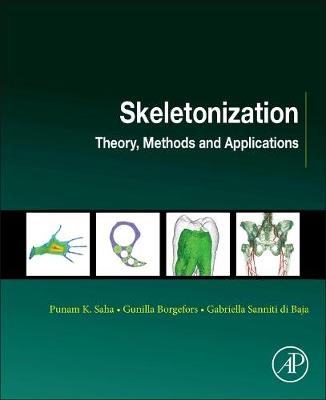
Skeletonization
Academic Press Inc.(London) Ltd (Verlag)
978-0-08-101291-8 (ISBN)
Part I includes theories and methods unique to skeletonization. Part II includes novel applications including skeleton-based characterization of human trabecular bone micro-architecture, image registration and correspondence establishment in anatomical structures, skeleton-based fast, fully automated generation of vessel tree structure for clinical evaluation of blood vessel systems.
Punam Kumar Saha received his Ph.D. degree in 1997 from the Indian Statistical Institute, where he served as a faculty member during 1993-97. In 1997, he joined the University of Pennsylvania as a postdoctoral fellow, where he served as a Research Assistant Professor during 2001-06, and moved to the University of Iowa in 2006, where is currently serving as a tenured professor of Electrical and Computer Engineering and Radiology. His research interests include image processing and pattern recognition, quantitative medical imaging, musculoskeletal and pulmonary imaging, image restoration and segmentation, digital topology, geometry, shape and scale. He has published over 100 papers in international journals and over 300 papers/abstracts in international conferences, holds numerous patents related to medical imaging applications, has served as an associate editor of Pattern Recognition and Computerized Medical Imaging and Graphics journals, and has served in many international conferences at various levels. Currently, he is an Associate Editor of the IEEE Transactions on Biomedical Engineering and the Pattern Recognition Letters journals. He received a Young Scientist award from the Indian Science Congress Association in 1996, has received several grant awards from the National Institute of Health, USA, and is a Fellow of International Association for Pattern Recognition (IAPR) and American Institute for Medical and Biological Engineering (AIMBE). Gunilla Borgefors was born in 1952 and received her Master of Engineering in Applied Mathematics from Linköping University, Sweden in 1975. After a Licentiate in Applied Mathematics from the same university she got her PhD in Numerical Analysis from Royal Institute of Technology, Stockholm in 1986. During a sabbatical she received a Master of Journalism at Uppsala University, Sweden in 2007. She was employed at Dept. of Mathematics at Linköping University as a Researcher and Teacher and Researcher 1873-1981. Then she moved to National Defence Research Establishment in Linköping in 1982 and ended as Director of Research and the Head of the Division of Information Systems. In 1993 year she became a full professor in Image Analysis at Swedish University of Agricultural Sciences, Uppsala, dividing her time between the aforementioned university and Uppsala. Borgefors is a Fellow of International Association for Pattern Recognition (IAPR) since 1998 and of Institute of Electrical and Electronics Engineers (IEEE) since 2008. Nationally she is member No. 19 of Royal Society of Sciences in Uppsala since 2000 and of Royal Swedish Academy of Engineering Sciences (IVA) since 2011. She has had many positions of trust in IAPR, such as 1st Vice President, Secretary, and several Committees’ Chair and member. After being an Associate Editor in Pattern Recognition Letters since 1998 Borgefors became one of its three Editors-in-Chief 2011. She is in the Steering committees for "Discrete Geometry for Computer Imagery" and "International Symposium on Mathematical Morphology" and has been involved in various roles in close to a hundred international conferences. Borgefors research interest is in various aspects of discrete geometry and on description, manipulation and analysis of digital shapes, preferably in 3D, and in applications of such methods to virus recognition, wood and plant cell analysis, wood fibre and blood vessel networks, areal and satellite photo analysis of woods and fields, to mention a few. She has written well over a hundred scientific articles and is cited more than 7000 times. Gabriella Sanniti di Baja received the laurea degree (cum laude) in physics from the "Federico II University" of Naples, Italy, in 1973, and the PhD honoris causa from the Uppsala University, Sweden, in 2002. She has been working from 1973 until 2015 at the Institute of Cybernetics E. Caianiello of the Italian National Research Council (CNR), where she has been director of research, and is currently an Associate Researcher at the Institute for High Performance Computing and Networking, CNR. Her research activity is in the field of image processing, pattern recognition and computer vision. She has published more than 200 papers in international journals and conference proceedings, is the co-editor-in-chief of Pattern Recognition Letters, has been President of the International Association for Pattern Recognition (IAPR) as well as of the Italian Group of Researchers in Pattern Recognition (GIRPR), is IAPR Fellow and Foreign Member of the Royal Society of Sciences at Uppsala, Sweden.
1. Skeletonization and its Applications- a Review
2. Multiscale 2D medial axes and 3D surface skeletons by the image foresting transform
3. Fuzzy Skeleton and Skeleton by Influence Zones: A Review
4. Unified Part-Patch Segmentation of Mesh Shapes using Surface Skeletons
5. Improving the Visual Aspect of the Skeleton and Simplifying its Structure
6. Curve Skeletonization using Minimum-Cost Path
7. Parallel skeletonization algorithms in the cubic grid based on critical kernels
8. Critical Kernels, Minimal Non-Simple Sets, and Hereditarily Simple Sets in Binary Images on n-Dimensional Polytopal Complexes
9. Characterization of Trabecular Bone Plate-Rod Micro-Architecture using Skeletonization and Digital Topologic and Geometric Analysis
10. Image Registration and Correspondence Establishment in Anatomical Structures based on Skeletonization
11. Skeletonization: Theory, Methods, and Applications
12. Skeletonization in Natural Images and Its Application to Object Recognition
| Erscheinungsdatum | 14.06.2017 |
|---|---|
| Verlagsort | London |
| Sprache | englisch |
| Maße | 191 x 235 mm |
| Gewicht | 860 g |
| Themenwelt | Informatik ► Grafik / Design ► Digitale Bildverarbeitung |
| Technik ► Nachrichtentechnik | |
| ISBN-10 | 0-08-101291-8 / 0081012918 |
| ISBN-13 | 978-0-08-101291-8 / 9780081012918 |
| Zustand | Neuware |
| Informationen gemäß Produktsicherheitsverordnung (GPSR) | |
| Haben Sie eine Frage zum Produkt? |
aus dem Bereich


